If you have limited or no experience with electric fencing, this guide is right for you.
A correctly constructed electric fence is safe and secure for people, pets, and livestock.
It’s also ideal for fencing out predators, such as bears, protecting your property.
Still, you must follow all steps to precisely and correctly install & use the electric fence for bears.
So, how to do so? Please inspect the guide below.
Table of Contents
- How dangerous are bears?
- How to effectively deter bears?
- What are the most productive electric fence types?
- Are cost-effective fences reliable?
- How do correctly install & use the electric fences?
- How does an electrified fence work?
- What are the main components of an electric fence for bears?
- How to deal with gates in electric fencing?
- Is net fencing also effective against bears?
- Frequently Asked Questions
- Final thoughts
How dangerous are bears?
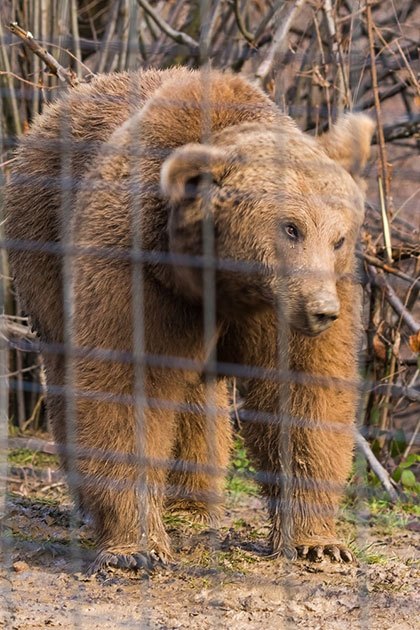
Although many believe bears are nocturnal animals, they are primarily active during the day. But, to avoid humans, they can wait the night time.
As they have a stronger sense of smell than dogs, they find a food source quicker.
That’s why bears are dangerous close to livestock, beehives, chicken coops, carcass dumping sites, or dumpsters.
Hence, it would be best to use electric fences to prevent bears from jeopardizing your domestic animals.
According to the Alaska Department of Fish & Wildlife News, the biologists working in the Hallo Bay in Katmai National Park encountered a bear.
Fortunately, an electric fence with a 12V battery & solar charger prevented the predator from stepping in.
Yet, sometimes, electric fences might not be sufficient. So, it would be best if you had extra bear-resistant strategies to keep them out.
What are these? Read below.
How to effectively deter bears?
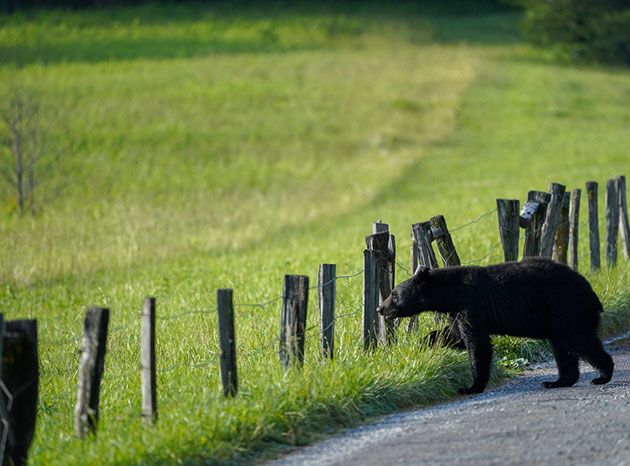
As numerous wildlife experts state, you must obey the following permanent fencing parameters to deter bears:
- 7-inch wire design and a 42-inch electric fence height: The electric fencing performs excellently to keep the black and grizzly bears out. But, it allows elk and deer safety pass.
- 7-inch wire design with a 54-inch electric fence height: The permanent fencing is primarily applied to prevent wolves and black and grizzly bears. Yet, it’s also ideal for deterring predators from lambing and calving areas with lower or moderate potential for wolf activities. Besides, the electric fence structure is properly deterring bears from chicken coops and beehives.
- 9-11-inch wire design & a 60-72-inch electric fence height: This is the most productive and effective construction for wolf and bear safety, especially when the predator risk or activity is higher.
What are the most productive electric fence types?
As electric fencing contains farm animals, you can use it to prevent specific predators, such as bears, dogs, wolves, and coyotes, from stepping in.
Yet, when your electric fence is working correctly, the electricity mechanism will be effective and productive to allow coexistence and minimize the risks of threats.
Numerous variations of electric fences deter larger predators.
But, for smaller-scale operations, electric fencing provides excellent protection to:
- beehives,
- bone piles,
- dumpsters,
- corrals,
- lambing,
- calving areas,
- and all other areas requiring deterring bears & similar predators.
As wild predators are motivated by their prey, the animals on the other side of the fence line will be the primary target.
Yet, the farm animals become conditioned with the electric fencing. Namely, the electricity provides a shock when touching the fence line.
Thus, your enclosed friends will avoid a close touch after a shock or two. But, to obtain the main target & food, predators might be persistent even after repeating shock sessions.
Therefore, the electric fences must serve as the primary physical barrier & shock severely.
In addition, the electric fence must be solid and sturdier, and higher than the animals. Additionally, the wires must be closely spaced.
To achieve this, you should opt for the permanent high-tensile fence mechanisms to prevent the predators from destroying your enclosed animals.
However, to be successful, you should install the permanent fences before the risk of predators is too high.
Simultaneously, your enclosed friends will get used to the electric fence earlier.
Are cost-effective fences reliable?
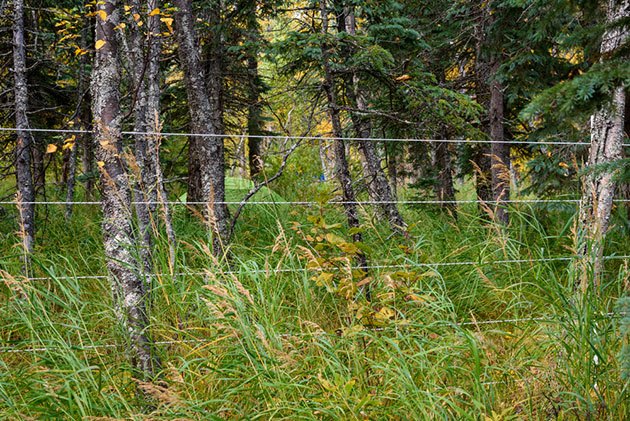
As the Alaska Department of Fish & Wildlife states, the high-tensile fences are the most effective against the bear attack when working properly.
The units are lightweight and portable, with two D-cell batteries, suitable for backpackers and others recreating in a bear country.
Thus, the Alaska Department of Fish & Wildlife claims that numerous models weigh less than four pounds, cover 30×30 feet areas & cost about $300.
Still, although many praise the models, many campers in the bear country complain about their impracticality for the guided trips or a clean camp.
So, the Fish & Wildlife experts conclude that without a proper setup & maintenance, you can not protect your property from a bear attack.
Luckily, the Interagency Grizzly Bear Committee came up with various solutions, so you can check the list and the electric fence video to find the best models.
Read more —
Who’s the Boss? The Best Electric Fence for Buffalo & Useful Tips for Owners
How do correctly install & use the electric fences?
Before we move on to the electric fencing applications, you should determine the following steps:
1. How much of an area must you enclose?
For a more extensive orchard, pasture, or similar property, you must consider the size of the energizer powering your electric fencing.
Larger acres need more joules to provide optimal performance to the entire fence.
2. Will you ever remove the electric fencing?
If yes, choose lightweight, temporary fencing. These are easy to move and install. Most likely, the constructions contain fiberglass or plastic posts and poly wire.
Still, hog or cattle panels might create smaller enclosures with numerous fence line units attached to the outside of the electrical construction.
Although temporary models are more accessible than permanent fencing, a permanent fence requires less maintenance for optimal working conditions.
3. Will the fence both prevent bears & protect inner animals?
Please find a local agriculture Extension agent or similar livestock experts to find the best electrical solutions, and help you train them to obey the rules of the electrified fence.
4. What about weather conditions?
Pay attention to the winter period, maintain the fences regularly, and check the battery life. Some batteries might die too soon, freeze or not recharge optimally in heavy snow.
And, as the electrified fence relies on the ground to deliver an electric shock, ensure the environment is optimal.
If the ground is too dry, the fence will be on dry, rocky soil without a shock effect.
In addition, when the fence crosses concrete, pavement, or wood, you must install a ground-returning fencing system. So, selecting the proper ground rods plays a crucial role here.
How does an electrified fence work?
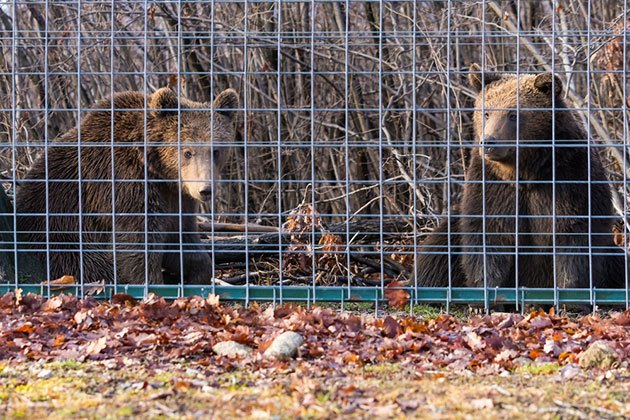
When an animal touches the fence wire and the ground simultaneously, the electrical current passes from the wire through the animal into the ground.
Then it travels to the ground rod and back to the energizer. And once the current is complete, the animal receives a shock.
But, if the soil is too dry, the electrical current cannot be completed, and the animal will receive little or no shock.
Specifically for bears, the electric fences must be higher to prevent climbing over, under, or through the fencing without receiving a shock.
So, the proper electricity requires constructing fences that:
- provide multiple electric wires
- combine electric and ground-returning wires
- connect wires outside of the existing electrified fence
- are prefabricated electric nettings.
What are the main components of an electric fence for bears?
Correct electric fences for bears contain 6 primary components, including:
- Energizers
- Wires
- Grounding system (ground-return fences & all-hot fence)
- Posts
- Voltage meter
- Insulators.
Still, depending on the fence models and their purpose, you can use extra accessories, such as on/off throwing switches, and you can/don’t have to use them.
So, check the basic and advanced requirements for a correct application.
1. Energizers
These are the primary power source of the fences.
They come in different models, but their primary function is to store energy & deliver it in short pulses through the wires.
So, to effectively keep bears away, the pulse rate is between 45 and 60 per minute or 1.0 to 1.5 pulses per second.
Moreover, energizers use energy measurements called joules. They measure released or stored energy.
The number of the stored joules is always higher than the released. Still, the higher the joule ratings, the higher the amperage. So, the stronger the shock will be.
Bears seem to be afraid only of the most powerful shocks. So, to deter them, you need a minimum joule rating of 0.7-1.0 stored joules & 0.5-0.7 released joules.
Also, remember that only low-impedance is recommended for deterring predators. This is because they have shorter but more energetic pulses.
And you can choose three energizer types:
- Solar energizer – consisting of the solar panel attached to the DC energizer and the battery. You must install the solar energizer in sunny places. But, as they come in parts – panel, energizer, and battery, it’s the most expensive unit.
- DC-fence chargers – receive the power from 6 or 12V DC – deep cycle marine batteries. It’s versatile and suitable for different locations of the fences. Yet, it doesn’t contain a battery. It requires regular maintenance, unlike the AC energizers. And, the pulse rate MUST be 45-60 per minute.
- 110-volt AC energizer – it attaches to the standard household current of 11oV. It’s the least expensive & most straightforward to use model. It offers 50-60 pulses per minute, needs lesser maintenance, and receives constant power.
2. Wires
Aluminum wire or galvanized smooth steel wire should always be used with the permanent fences.
The first is lightweight and easy to use, yet the wire might break with repeated bending. The latter is durable and robust, yet not ideal for small fence construction.
Whatever your choice might be, ensure you use 12 or 14-gauge wire construction. But, you should consider even a 16-gauge wire structure for smaller buildings for short distances.
On the contrary, larger fences should use 10- or 12-gauge wires for longer distances.
For temporary fencing, use a poly wire – polyethylene wire. These wires contain multiple wire strands braided within with a poly rope.
The poly wire is strong, durable, and flexible, so you can roll it multiple times without breaking. Yet, the wire might harm due to excessive exposure to sunlight.
To connect all parts and deter bears, use standard 10 or 14-gauge wire models. The wire is called an insulated wire, rating 20,000V.
Do not use industrial or household wire as it provides less than 1,000V. It’s not enough for a fence.
Finally, never electrify the barbed wire or use it as a ground-return wire!
Construction models
According to the applications and purpose, you can either use wire panels or net-wire fencing with or in place of a single-stranded wire fence.
You can raise them off the ground & attach them to the fiberglass posts and completely electrify them.
Also, it would be best if you connected them to the energizer’s positive terminal.
The panels are fully electrified as they’re raised above the ground, similar to the all-hot wire constructions.
An alternative is to use the panels or netting as the ground wire or ground-return wire constructions.
But, you would need three additional wires outside of the structure to prevent the bear from ruining the fence.
All of them would be attached to the energizer’s negative terminal.
So, when the bear touches the wiring system – hot wire, ground wire, and other units, it will receive a powerful shock that does not travel to the ground to complete the circuit.
3. Ground rods
To function correctly, a fence must have a correct grounding system. Without it, it cannot shock animals.
The pulse must travel through the ground rod and back to the energizer to hit the animal.
So, the fence needs 3-6 feet of ground rod per joule of storing energy. And galvanized steel rods are 6-8 feet.
Still, you cannot crate too much grounding in the fence construction!
Inappropriate fence structures are a crucial problem with the fence performance, specifically for rocky and sandy soil.
A ground rod should be 0.5 inches in diameter and made of galvanized steel.
Copper models are an alternative, yet you must use ground wires and clamps to prevent corroding connectors.
Remember that the wire must be rated 20,000V for conducting electricity properly.
All-hot fence models
These are suitable for all-year moist soils. In the system, all wires are hot.
One hot wire is connected to the positive terminal, and the other is attached to it.
The negative terminal is connected to the ground rod. So, when a bear stands directly on the soil, it receives a shock.
To keep the bear away, you need at least five hot wires. The lowest is 8-12 inches above the ground, while the highest is 36-42 inches above.
Ground-return structures
These are ideal for dry soil or poor conductors of electricity. The system has alternating hot and ground wires.
One hot wire is attached to the positive terminal while others are in the series. Likewise, one ground wire is directed to the negative terminal, while others are in the series.
The rod is also connected to the negative terminal. So, the animal touches both hot and ground wires to receive a shock.
You also need a minimum of five wires. The lowest should be 8-12 inches above the soil, and the highest 36-42 inches tall.
4. Posts
The main difference between a permanent and temporary fence is the choice of the fence posts and the installation extent.
For the corner posts, you should use wood posts. They’re also ideal for permanent and low-maintenance fence designs.
For temporary fencing, you should use either fiberglass or metal T-posts. Seasonal applications of the portable fences also use either fiberglass or plastic posts.
T-posts (metal posts) and wooden posts should be placed at the corner posts or gates.
Yet, flexible fiberglass or plastic posts need supporting lines when placed on the outside corners and if the fence has an abrupt ending.
5. Voltage meters
To determine the effectiveness of the physical barrier, you must regularly maintain it. It would help if you had a voltage meter, also known as a fence tester, to do so correctly.
The tester shows you whether the fence works correctly and the exact amount of voltage passing through the fence wires.
Remember, the device is not the same as the voltage reader. The reader only shows if the electrical current passes through the fence wires.
Bears require a minimum of 5,000 or 7,000V for a successful deterring, depending on their level of experience and the species.
The meter comes in wide varieties – from cheaper to more expensive models.
So, you can find LED lights, precise readings, and other following elements for optimal fence performance.
In addition, the meters created for households or cars can not be used with the electric fence systems.
It would be best to use them after the fence installation and as a part of regular maintenance.
6. Insulators
Wooden and metal T-posts need additional insulators that prevent a wire from leaking the power and energy into the soil through conductive materials.
They also keep the wires away from the fence posts.
The majority of insulators are made of ceramic or plastic, screwed on wooden posts, or clipped onto T-posts.
As there are limitless designs, you must look for the most fitting one for your electric fence.
If you use wires added to the wire panels or net-wire fence systems, you should search for insulators that will keep the wires 4-6 inches away from metal fencing and posts.
Regarding end and wooden corner posts, you should use heavy-duty lag-corner bolts and place them to ensure the wire completes a 90-degree turn without any part touching the fence post.
For plastic and fiberglass posts, you don’t need insulators. These materials are non-conductive.
However, they have built-in clips or notches holding up fence lines and wires. Or you can directly drill the holes through the posts to feed the electric wiring now.
How to deal with gates in electric fencing?
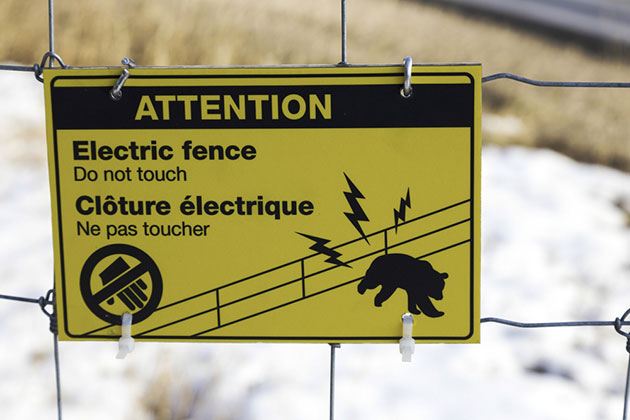
If the gate is the only non-electrified place of the fence, a bear might quickly enter it, so you fail to protect beehives, chicken coops, fruit trees, and everything else behind the fence.
Thus, you should electrify gates as well. Again, ensure the lines are outside the gate but keep them away from the gate handles.
The lines are electrified by attaching one wire to the main fence with the insulated wire.
Yet, attach them in a series to the wire connected to the primary fence to electrify extra lines.
So, to properly connect the two sections, the insulated wire can run under or over the gate if the archway exists.
But, please, pay attention to the gate handle.
Is net fencing also effective against bears?
These structures can also keep unwanted visitors away. Their primary purpose is to protect the enclosed animals and scare away the predators.
So, you can use these constructions to protect beehives, orchards, chicken coops, deer feeders, etc.
The net fencing is a combination of vertical and horizontal poly wiring units attached to the step-in-the-grounding fence posts.
Depending on the bears, they come in various sizes, between 25 and 164 feet in length, creating longer or shorter fences.
The units do not require extra tools and materials for installation, except for the grounding rod and energizer.
The units don’t need to return to the starting position to function.
Still, to properly use them, you must regularly maintain the systems, and they’re meant for temporary uses only.
Thus, you must remove them for weed mowing or cutting, they don’t handle snow or ice, and you must regularly adjust them to prevent sagging and entry of the bear.
Although they don’t deter deer, they might damage the construction and let the bear in when jumping over.
The net system also contains an all-hot or grounding-return mechanism. But, to eliminate a threatening bear, the latter design is required.
Frequently Asked Questions
Will an electric fence keep out bears?
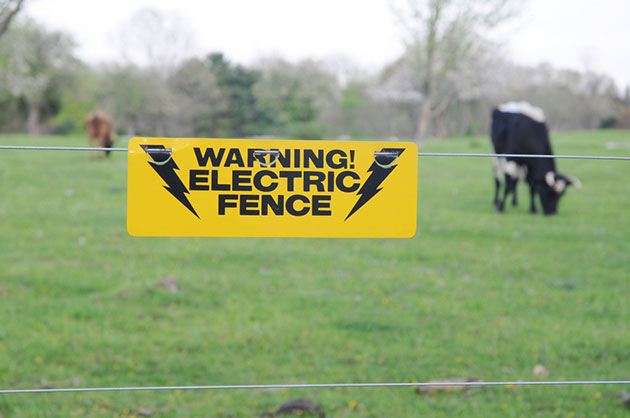
Yes, it will if you install and use it properly. Check the guidelines and components, and ensure the proper maintenance.
How strong are electric fences for bears?
These predators only respond to powerful shocks, so the overall structure must be solid and robust. But, the power must be 0.7-1.0 Stored Joules or 0.5-0.7 Output Joules.
How many joules does it take to deter a bear?
You will need 0.7-1.0 Stored Joules or 0.5-0.7 Output Joules to deter bears completely.
What size electric fence charger do I need for bears?
You will need at least 4-feet high posts, with a minimum of five lines, a minimum voltage requirement of 6,000V, and a minimum of 0.7-joule condition.
Final thoughts
As you can see, there are various factors to consider when choosing the corresponding electric fence for bears and other predators away from your property.
Still, the crucial steps are to correctly install, maintain the fences, and examine all the components thoroughly to find the best solutions for your needs.
Of course, you mustn’t forget the minimal determinants regarding power, voltage, size, and lines to effectively deter predators.
It would be best to consult experts if you have difficulties with the choice units.
